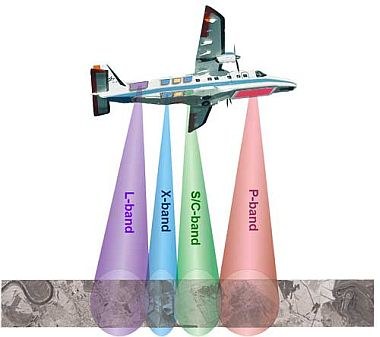F-SAR - DLR's Airborne SAR System
F-SAR is the successor of the E-SAR system and is presently flying in several antenna configurations (ATI, fully polarimetric) in X band. Its maiden flight was in November 2006. This new development was triggered by the strong demand of E-SAR users and customers for data being simultaneously acquired at different wavelengths and polarisations as well as by the demand for very high range resolution. F-SAR is a totally new development utilizing most modern hardware and commercial of the shelf components.
The F-SAR Concept
- full modular system in X, C, S, L and P bands,
- full polarimetric capability in all frequencies,
- single-pass polarimetric interferometry capability in X and S bands,
- four recording channels with data rates of up to 2 Gbit/s per unit,
precise internal calibration (relative accuracy better than 1 dB), - fully reconfigurable operation modes including capability for digital beamforming on receive,
- additionally, also repeat-pass Pol-InSAR as standard measurement mode for ensuring baseline flexibility.

F-SAR Technical Parameters
X | C | S | L | P | |
|---|---|---|---|---|---|
Carrier frequency [GHz] | 9.60 | 5.30 | 3.25 | 1.325 | 0.35 |
Bandwidth [MHz] | 800 | 400 | 300 | 150 | 100 |
PRF [kHz] | 5 | 5 | 5 | 10 | 12 |
Output [kW] | 2.50 | 2.20 | 2.20 | 0.70 | 0.70 |
Resolution Range [m] | 0.3 | 0.6 | 0.75 | 1.5 | 2.25 |
Resolution Azimut [m] | 0.2 | 0.3 | 0.35 | 0.4 | 1.5 |
- Strip width – 12.5 km (at maximum bandwidth)
- Sampling – 8 bit real; 1Gsample/500Msamples selectable; max. number of samples 64K per rangeline; 4 recording channels
- Data rate – 247 MByte/s (maximum per recording channel)
The radar is designed to cover an off-nadir angle range of 25 to 55 degrees at altitudes of up to 6000 m above sea level, which is the maximum operating altitude with the DO228.
A central computer unit controls the radar via CAN bus and Ethernet. There are 4 modes of operation:
- System configuration,
- System test,
- Internal calibration and
- Radar operation (nominal mode).
The required synchronous timing and clock signals are generated in the main timing unit with less than 6 ps jitter and rise times of less than 80 ps. A 50 MHz ultra-stable Quartz oscillator is the reference. The IGI D-GPS/INS based precision navigation system delivers a GPS 1PPS signal which regularly triggers an absolute time stamp in the raw data header.
In its basic configuration the radar operates with four 1GSample-ADCs. The timing unit allows for two additional ADCs. Each ADC unit has raw data formatting integrated thus the number of recording channels can be easily increased if need be. Via optical fibre high speed data recording units are connected. A second optical fibre links the ADCs to the control computer (monitoring bus) for internal calibration and system monitoring. Quick-look processing will be implemented via dedicated hardware and optical fibre link to the data recording units. On- and/or off-line operation is possible.

Airborne platform and antenna mount
As for E-SAR, DLR’s Dornier DO228-212 aircraft was the first choice as platform for the new system. Alternative solutions for a more suitable aircraft with improved performance in terms of flight range and altitude are being investigated in order to better cope with requirements of future campaigns and missions.
A new antenna mount designed to fix planar array antennae to the Do-228 aircraft has been developed. Fully-fledged in multi-frequency configuration it holds 7 right-looking dual polarised antennae: X band (3),
C band (1), S band (2) and L band (1). The P-band antenna is mounted under the nose of the aircraft as for E-SAR.
One important advantage of the antenna mount is that it makes it easier to change antenna configuration and to mount other antennae avoiding individual airworthiness certification procedures the same time
